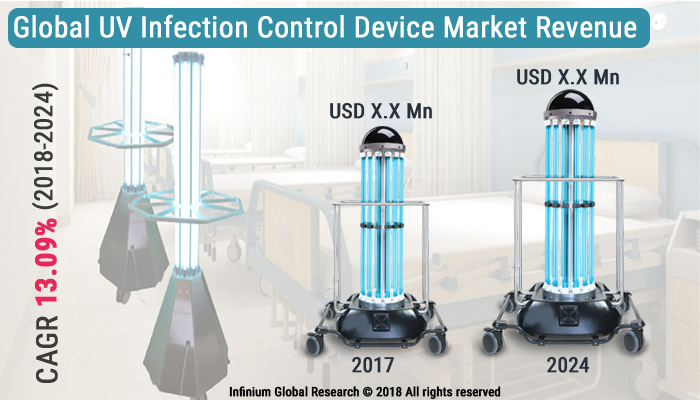UV Infection Control Device Market (Type - Mobile Type and Stationary Type; End Use - Hospitals, Medical Device Companies, Clinics & Laboratories, Pharmaceutical Companies and Food Industry and others; Region - North America, Europe, Asia-Pacific, and Rest of the World): Global Industry Analysis, Trends, Size, Share and Forecasts to 2024
A recent report published by Infinium Global Research on UV infection control device market provides an in-depth analysis of segments and sub-segments in global as well as regional UV infection control device market. The study also highlights the impact of drivers, restraints and macro indicators on the global and regional UV infection control device market over the short term as well as long term. The report is a comprehensive presentation of trends, forecast and dollar values of global UV infection control device market. According to the report the global UV infection control device market is projected to grow at a CAGR of 13.9% over the forecast period of 2018-2024.

Market Insight
UV infection control device is a cost-efficient and easy-to-use physical disinfection method which does not leave disinfection by-products, its popularity is growing by leaps and bounds, reflecting positively on the growth of the worldwide market for UV disinfection equipment. UV infection control device emits UV light, which penetrates the cell of the microorganism and completely disrupts its DNA, and kills the cell on contact within a certain period of time.
Global UV infection control device market is showing a positive trend of development around the globe. There are many factors which are helping to boost this market such as increasing application in water treatment, wastewater treatment, air treatment, surface disinfection process-water treatment, healthcare, clinical laboratory, pharmaceuticals application, etc.
On the basis of region, the global UV infection control devices are segmented into North America, Europe, Asia, and the Rest of the World (RoW). North America dominates the UV infection control device market due to the presence of a UV infection controller device manufacturers, a high number of hospitals, clinics & laboratories, pharmaceutical companies, and water and wastewater treatment facilities, etc., which have boosted the demand for UV ICD solutions in this region. In addition, stringent regulations regarding sterilization and disinfection of water and limitations on the use of disinfectant chemicals have led to the adoption of UV ICDs solutions in this region. All these factors have boosted the demand for ICDs in the region.
Segment Covered
The report on the global UV infection control device market covers segments such as type and end use. On the basis of type, the global UV infection control device market is categorized into mobile type and stationary type. On the basis of end use, the global UV infection control device market is categorized into hospitals, medical device companies, clinics & laboratories, pharmaceutical companies, and food industry & others.
Geographic Coverage
The countries covered in the North America region include the U.S., Canada, and Mexico; while Asia-Pacific includes China, Japan, India, South Korea, Malaysia, and among others. Moreover, Germany, U.K., France, Spain, and Rest of Europe are included in the European region. The U.S. drives the growth in the North America region as it is the largest market in the region. The Asia-Pacific region offers substantial potential for the market growth owing to rapid growth in markets such as India and China. The APAC region is projected to experience growth at a CAGR of x.x% over the period of 2018-2024.
Companies Profiled:
The report provides profiles of the companies in the global UV infection control device market such as Getinge Group, STERIS, Clorox Professional, Xenex, Tru-D SmartUVC, Seal Shield, American Ultraviolet, UVC Cleaning Systems, Infection Prevention Technologies, and AquiSense Technologies.
Report Highlights:
The report provides deep insights on demand forecasts, market trends, and micro and macro indicators. In addition, this report provides insights into the factors that are driving and restraining the global UV infection control device market. Moreover, IGR-Growth Matrix analysis given in the report brings insight into the investment areas that existing or new market players can consider. The report provides insights into the market using analytical tools such as Porter's five forces analysis and DRO analysis of UV infection control device market. Moreover, the study highlights current market trends and provides forecast from 2018-2024. We also have highlighted future trends in the UV infection control device market that will impact the demand during the forecast period. Moreover, the competitive analysis given in each regional market brings insight into the market share of the leading players. This report will help manufacturers, suppliers, and distributors of the UV infection control device market to understand the present and future trends in this market and formulate their strategies accordingly.
